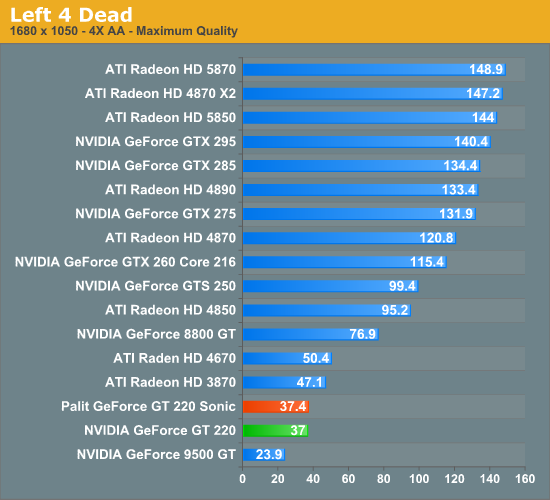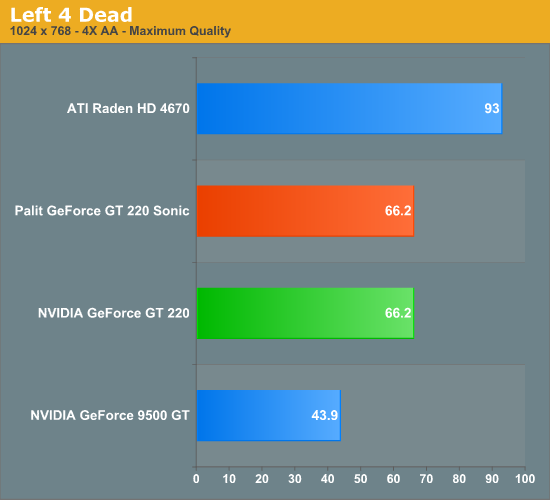NVIDIA’s GeForce GT 220: 40nm and DX10.1 for the Low-End
by Ryan Smith on October 12, 2009 6:00 AM EST- Posted in
- GPUs
Left 4 Dead
Valve’s venerable Source engine continues to roll on with Left 4 Dead, their co-op zombie shooter. As the Source engine is CPU limited, this is another title that low-end cards can do well at.



Just to drive home the point of how easy it is to run Left 4 Dead, we left anti-aliasing on for all of these benchmarks. Even with 4x AA, the GT 220 turns in a playable 37fps at 1680x1050. The gap between it and the 4670 remains however.










80 Comments
View All Comments
chizow - Monday, October 12, 2009 - link
Is this the one you're referring to Ryan?http://www.newegg.com/Product/Product.aspx?Item=N8...">http://www.newegg.com/Product/Product.a...E1681412...
From all reports and feedback I've seen, that Asus part is 96SP for $40 AR (was actually $35 at one point!) just as Ben stated.
I don't really care about this segment of parts for actual 3D so you may be right. I was only interested in that Asus 96SP because it was identified by many users as "the card" to get for dedicated PhysX on a budget. I was hoping to find a low-power consumption candidate on 40nm for dedicated PhysX, but it seems these parts have too few SP to be viable.
BenSkywalker - Monday, October 12, 2009 - link
Why not include benches of the nV part that you quoted the price for then(btw- NewEgg is also listing one of the 384MB 96SP 9600GSOs for $56.49)?It is rather misleading to put it mildly that you decide to include benches for one part that is quite a bit cheaper, and quite a bit slower, and then quote the price on the next rung up on the performance ladder. It would be akin to showing benches for the GTX275 and lamenting it because the GTX285 was so expensive, it doesn't make any sense.
Ryan Smith - Monday, October 12, 2009 - link
Which part? The 9600GT, or the 48SP GSO?What you see are all of the low-end cards we were able to get our hands on for this article.
jordanclock - Monday, October 12, 2009 - link
The graphs on the "Temperature and Noise" page are high-to-low. Usually they're the opposite, following the idea that lower numbers are better. I know, I know, it's a lame nitpick.As for the card: If they added this checkbox feature for OEMs (which I believe) then why bother allowing for retail distribution? This card really doesn't bring anything that isn't already done with cards they already have available. Seems like a rather silly release.
Ryan Smith - Monday, October 12, 2009 - link
Fixed. Thanks.jonup - Monday, October 12, 2009 - link
Ryan, the Palit table shows their 1GB card's frame buffer as 512MB.strikeback03 - Monday, October 12, 2009 - link
Seems recently there have been a lot of low-end cards with 1GB of memory onboard. Is this just a marketing ploy, or is there actually some scenario where it would be useful to have lots of memory but not much processing power?Concillian - Monday, October 12, 2009 - link
The 1GB on low end cards is a marketing thing. The "average consumer" equates more memory with performance and generally have little to no knowledge about the importance of GPU type, speed, or graphics memory bandwidth.nVidia and ATi have been taking advantage of this to help add profit margin since at least the GeForce 4 MX generation.
Zingam - Monday, October 12, 2009 - link
This will be one craptastic graphics card for the masses! Yay!Good luck, NVIDIA!
Dante80 - Monday, October 12, 2009 - link
This could have been a killer HTPC card...one year ago.I understand the need for nvidia to come up with sth for this market segment, and I like very much both the improved audio and the low power consumption.
But lets be honest here. This card has no place in the current retail market. It merely looks as a project to max margins for OEM use. OEMs can market a "Brand new card with a smaller process, DX10.1 support and 1 whole GB of memory goodness", but retail vendors and nvidia will have a hard time convincing anyone to buy this instead of going for a 9600 or a 4670.
Since margins seem godly, nvidia should lower the price and try to saturate the market segment with these cards in a HTPC (suicide) mission. That would at least make sense to consumers.